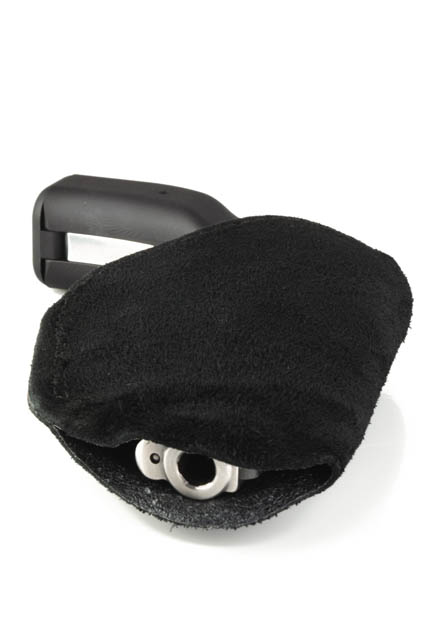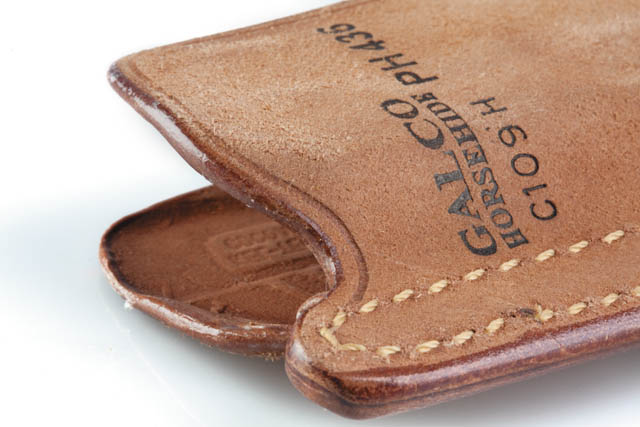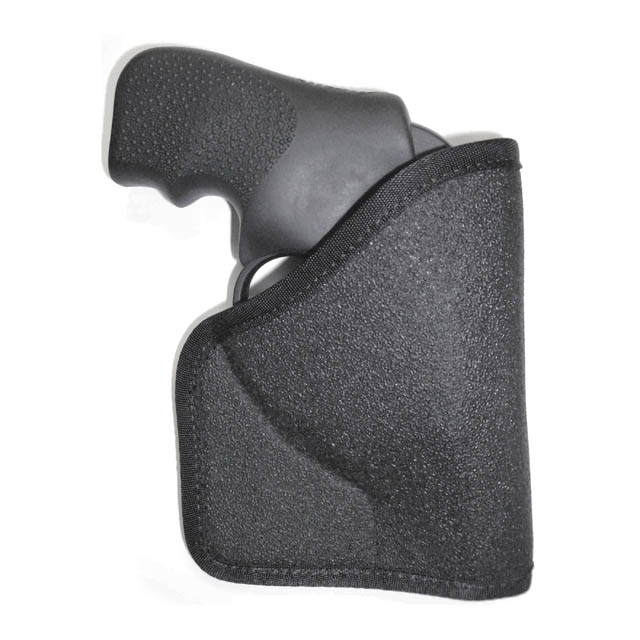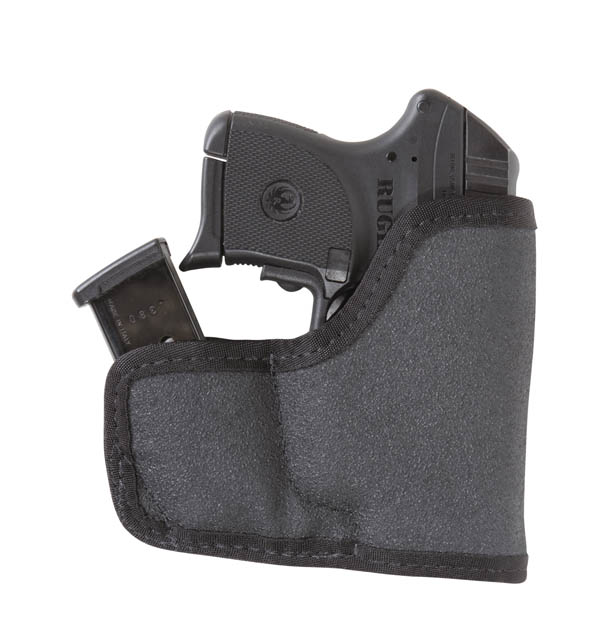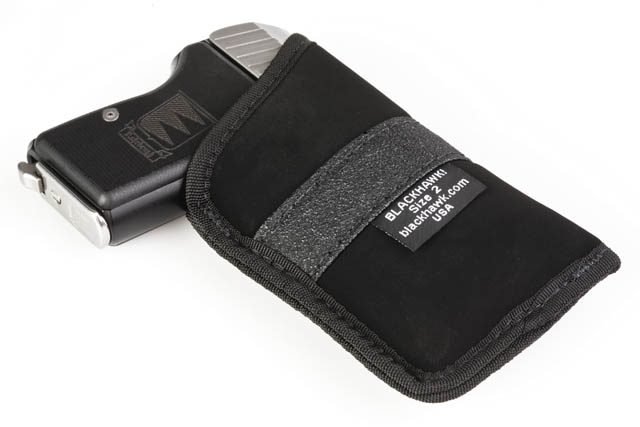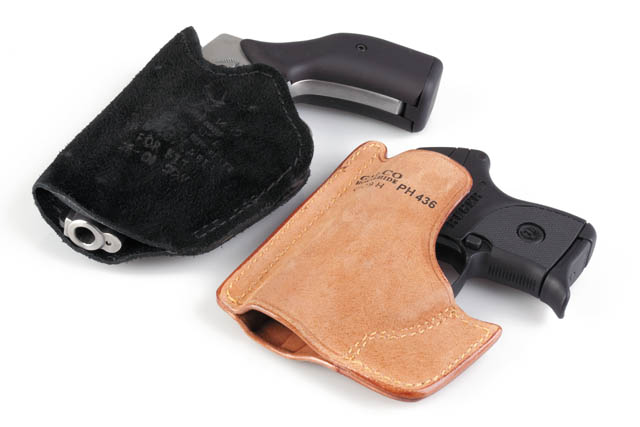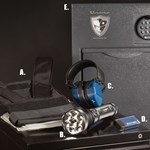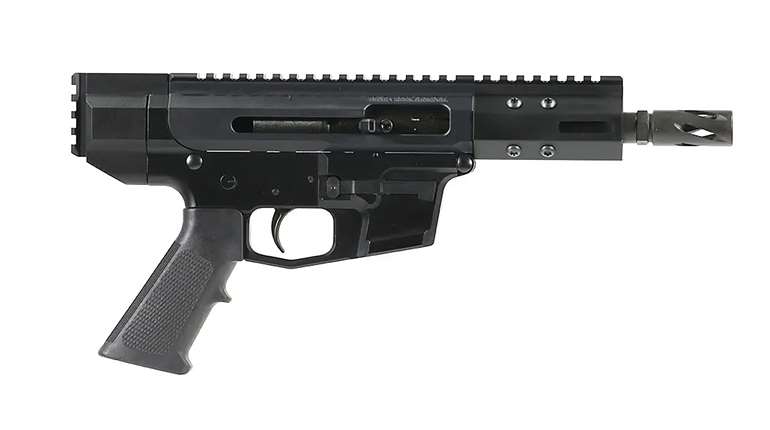
I always marvel at how movies portray people packing handguns. Rarely are they correct, but they are generally photogenic. Dramatic, too, for either the gun is worn in a way that makes the viewer constantly aware of its presence or it's drawn in a way that excites the audience.
Therefore, one might assume many of the holsters that do their job too well—actually concealing the handgun successfully—rarely make it to the big (or small) screen. And that's probably why pocket holsters are not seen in the stuff that comes from Hollywood studios.
The practice of carrying a small handgun in a pocket has been around forever. Westerners hid not only derringers, but also scaled-down revolvers like the Colt 1849 in vest, pants and coat pockets—often with reinforced linings to prevent premature wear and the firearm from printing through the fabric. Shaping the pockets was sometimes done for orientation, and I've even heard of coating the linings of internal pockets in overcoats and dusters to protect the firearm and allow for a slicker draw.
This concept continued as blackpowder handguns gave way to smokeless-powder models and semi-automatic pistols took off in popularity after World War I. Colt then offered the Pocket Positive, a shorter-barreled version of its small-framed Police Positive revolver. Countless American and foreign manufacturers have made tiny .25- and .32-caliber semi-autos, and .380 ACP pocket pistols have enjoyed a recent rebirth. Meanwhile, small-framed revolvers continue to be popular for everyday carry.
Problems in Your Pocket
Just dropping a handgun into a pocket isn't always the saving grace one expects. There are several major drawbacks and a few minor ones to consider.
First is printing—when the outline of the gun is visible through the carrying garment. This can be compounded by the clothing's fabric. Dark colors seem to work best, as do heavyweight fabrics. If the garment has some shape or body of its own—and does not drape revealingly against the gun—then that's good, too. Women's clothing is generally more problematic because even if the colors are helpful, the materials are usually much lighter than those worn by men, greatly increasing the likelihood of the gun's outline being seen.
Even if the clothing is capable of concealing a firearm, a gun's outline can wear into the garment over time. This can cause people to think you're carrying concealed on the days when you're not. There is internal wear to consider, too. If coins, keys and knives abrade their way through pockets, think about what the various surfaces of a pistol or revolver will do after a few months of being carried.
Those same surfaces can also snag on the pocket when drawing a handgun under stress. Sights and hammer spurs are the worst offenders, but magazine catches and floorplates can be an issue, too.
A properly designed pocket holster can minimize, if not eliminate, most of these issues. Made from the right material and given just enough mass—not too much lest it becomes bulky—a pocket holster can usually control printing. If the design and shape are correctly defined, snagging should not be an issue, either.
Shaping Up
Shape is one of the most confusing things to consider when it comes to selecting a pocket holster. My earliest samples, from the first part of the 20th century, are bovine in nature with regard to material, color, finish and detailing. Holster makers continue to produce modern-day versions of these hybrid concepts, such as a sculpted gun outline on one side molded to retain the firearm and a thick, non-defined surface on the other intended to minimize printing. Certain things have changed, however, and today newer shapes abound.
In some cases, the molding used to retain the handgun is kept inside the holster body, while the outside is purposely not contoured. This not only helps secure the pistol, but also cuts down on the chance of the gun printing. To reduce movement within a pocket, the exteriors of many of today's holster designs have a rough-out finish that grips the pocket fabric without abrading it. Some resemble a radical letter "V," where a hook-like projection is intended to engage the rear corner of the pocket, holding the holster in place and preventing it from coming out along with the gun.
Other holster makers have moved in dramatically different directions. Some manufacturers, especially those who use fabric-like synthetics, don't mold or shape anything—often creating very effective pouch-like containers to carry, orient and protect a gun within the pocket. While these holsters occasionally employ a synthetic, suede-like exterior to keep them from moving around, some go one step beyond with additional bands of rubbery, tacky-surfaced materials to keep the holster in place. Others form the entire exterior from a material that clings to such a degree the holster will not come out of the pocket unless removed intentionally.
No Sweat
Regardless of cost and shape, a well-designed pocket holster also serves to protect the firearm it carries. With the way this style of holster is worn on the body, it faces some very unique challenges.
The most obvious issues with carrying a handgun in a pocket are heat and humidity. Or to put it more bluntly: sweat. While gun-making materials and modern-day finishes are getting better all the time, things can still discolor, rust, corrode and rot if not properly protected. When carrying a handgun in a pocket, the liberal application of lubricants and rust inhibitors is not always advised. While such compounds can be used on externally holstered firearms without too much concern, excess lubricants on pocket-carried handguns can stain clothes.
So, keeping the gun slightly less protected from your body's perspiration means the holster is your primary line of defense against such damage. Models built from denser-fiber skins or synthetics that provide outright moisture barriers can do much to help in this area.
Pocket holsters can also protect your gun from less obvious—but often very serious—threats and damage. You'd think anyone wanting to carry a handgun in a pocket would remove everything else from it, but I can tell you that in my experience of traveling around the country and dealing with police and civilian members of the firearms fraternity, that isn't always the case. Items like keys and paperclips work their way into pistol bores.
Help From Within
In my concealed-carry presentations each year at the NRA Annual Meetings and Exhibits, I tell people all holsters—regardless of where they are worn on the body—should share certain traits. One of them is a covered trigger guard. Another is that all protruding surfaces should be accommodated so there is no interference with sights, levers or buttons. But, just as importantly, the ability to fully grip the pistol before making the draw should not impeded.
Without a holster, you must depend on the size and shape of the handgun corresponding to the size and shape of your pocket not only to contain the gun, but also to properly orient and maintain its position. When you reach for the gun, you should be grabbing its grip and not its slide, barrel or trigger guard. Generally, a pocket alone does not do a very good job of creating and preserving this dynamic. The gun is often in any position but the desired one, which makes it difficult—if not impossible—to draw and implement the gun without having to first make some sort of obvious and time-consuming adjustment.
A proper pocket holster places the butt or grip frame of the gun in an orientation that matches the hand as it enters the pocket. It also allows you to obtain a shooting grip on the handgun before it is drawn. That alone is worth the price of admission.
First, you can walk around with a gun that no one can see, but is easy for you to access. You can even go so far as to stand nonchalantly with your hands in your pockets looking, for all intents and purposes, bored with the world. All the while, however, you have one of those hands solidly attached to the pistol and ready to draw if needed.
One of the companies I worked for developed its pocket holster at the request of a statewide marine patrol to assist its plainclothes drug-interdiction activities. Often wearing nothing more than a pair of shorts, these officers had no pant legs to afford the use of an ankle rig. They had no shirt or covering garment to allow for belt carry, and they felt—even at the ocean—fanny packs had become passé. So, we first made a synthetic pocket holster that enabled them to carry a small, five-shot revolver concealed. We also designed a second holster to accommodate a small, semi-automatic pistol. The officers were thrilled because it enabled them to mingle with others or stand alone and never be seen as an armed person of any kind: police or civilian.
Below the Belt
In my classes, I address things like sight lines and how to take advantage of the natural shapes of the body that our brain sees, but discounts because we encounter them daily. If we don't see anything out of the ordinary, we just keep on going. But, as soon as there is a bulge not present among the general population, or a checkered surface that shouldn't be there, our brains stop and tell us to take notice.
A properly designed pocket holster and a correctly sized front pocket to accommodate it won't give off such signals. It should also be noted that most men don't like looking in the area of another man's groin or hip structure. Quite often, this zone is ignored altogether in such visual overviews.
Consider Before You Carry
So if these are all the benefits to employing a pocket holster, what are the drawbacks I mentioned before? There are a few.
Foremost are your activities. If you are driving all day long, this is not the holster for you. Holsters will not work from most pants pockets if you are seated and cannot stand up to draw. Obviously, restaurants can be an issue here as well. If seated at a table, you need room (and the practiced skill set) to stand up while clearing the table in order to produce the handgun to a conventional height. A booth can be an even greater problem, as most booth configurations simply won't allow you to stand.
Most pants won't permit a pocket-carried firearm to be removed when seated. However, some loose-fitting trousers with the right kind of side-entry pockets might allow a draw from that position. Differences in clothing styles and cuts have always greatly affected the use of these holsters, so you should make sure the clothes you purchase make sense for your preferred style of carry. Keep in mind that pocket holsters can also be employed in certain jacket and coat pockets as well.
Pocket holsters are a great choice for what some might consider deep concealment, without all the issues that one normally encounters in producing a firearm from such a well-hidden position. If this carry style fits with your activities and their accompanying mode of dress, and if you are reasonable about the size of the gun you plan to conceal, a holster may be one of the best things you can put in your pocket.
